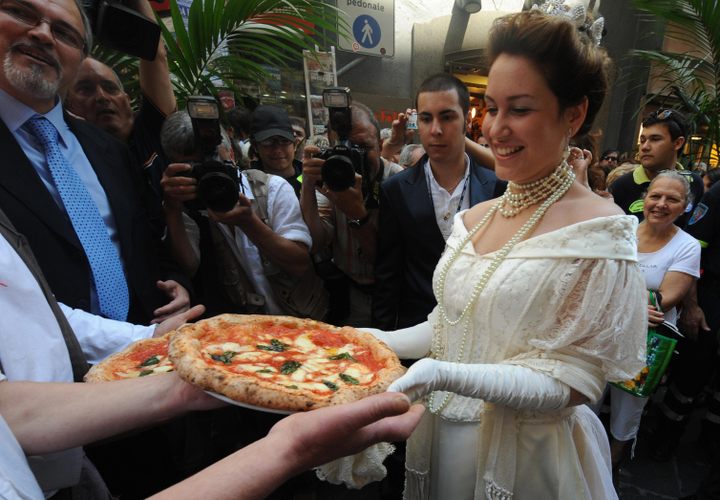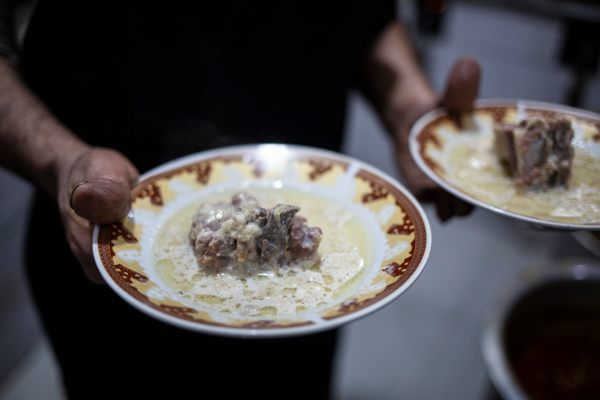

Debunking the Myth of the National Dish
Anya von Bremzen breaks down true origins of pizza, ramen, and other iconic foods in her new book.
In 1889, a rakish Neapolitan pizzaiolo by the name of Raffaele Esposito gifted three of his pies to Queen Margherita of Savoy, the beautiful Piedmontese wife of King Umberto I. As the story goes, he fashioned one with the colors of the freshly unified nation of Italy’s flag and named it, of course, pizza Margherita. A plaque in Naples proudly declares where the queen’s meal allegedly took place. There’s just one catch to this familiar tale: None of it is true.
In her latest book, National Dish: Around the World in Search of Food, History, and the Meaning of Home, Anya von Bremzen goes on a multi-year quest to parse the myths and misunderstandings swirling around canonical foods like pizza Margherita. In the process, she “crushes” bowls of noodles with a ramen otaku in Tokyo, learns to make pasta puttanesca in a former brothel in Naples, and drinks ceremonial cacao at her own wedding in Oaxaca.
The book brims with enticing descriptions of how Iberian jamón “has the mildly intoxicating effect of a slow-release endorphin bomb, as its dewy fat coats your tongue” or how a newly made corn tortilla “breathes and undulates and balloons like a delicate primeval life form.” But interwoven throughout the glossy veneer of a travelogue is an investigation of the often fraught relationship between national identities and the cuisines that help define them.
Von Bremzen, a three-time James Beard award winner and the author of six books, is fascinated with the political mechanisms behind what ends up on our plates. Born in Soviet Moscow, she has a keen sense for spotting jingoistic propaganda and a deep-rooted aversion to fetishized notions of cultural authenticity. In her previous works, Mastering the Art of Soviet Cooking: A Memoir of Food and Longing and Please to the Table: The Russian Cookbook, she set about unpacking the complexities of the cuisines of a disparate fallen empire.

In her new book, she turns her critical lens on how autocrats and empires have wielded food as a tool for erasure, suppression, and identity-building throughout the world. “The Ottomans knew this,” she writes. “They conquered by the sword, but legitimized and manipulated their power through soup.”
In the process, she tackles how Spanish tapas have a lot to do with Francisco Franco’s fascist ambitions, on how Spanish colonizers and U.S. trade policies systemically repressed Indigenous Mexican foodways. Her final chapter tackles borscht, the heavily disputed soup claimed by both Russians and Ukrainians that has taken on a dark new significance under Vladmir Putin’s ongoing war.
It’s weighty subject matter, to be sure, but as von Bremzen says, “It doesn’t have to be a bummer.” National borders and identities may be largely constructs, but that in no way makes these foods less of a joy to eat. By the end of the book, readers may find themselves searching for plane tickets—and asking a lot more questions about who gets to tell our food narratives and why.
Gastro Obscura caught up with von Bremzen on a phone call from her home in Jackson Heights for a conversation about the collapse of empires, the power of corn, and who has the right to claim a cuisine.
You have a line in the book in which you say, “I’m a Jewish-Russian American national, born in a despotic imperium, long deleted from maps.” How did your own background influence the project?
On the one hand, it made me very aware of how political food is and how political cookbooks are.
The other aspect that really influenced this current book is that as Please to the Table, my cookbook about the cuisines of the former USSR, came out, the empire went bust, and the former Soviet republics became independent nations. So you saw this nation-building as it was happening in real time. Friends were joking to me, “You better make your book a tear-off calendar.”
Then I started revisiting post-Soviet spaces 10 years after, then 20 years after the collapse of the USSR. I saw the creation of new cuisines, canons of these post-Soviet nations reasserting their culinary identity and sometimes maybe even inventing things or going back to pre-Soviet times.
It’s not just the recipes that changed. It’s the narrative, the conversation around what is a national cuisine for these republics changed. The same thing happened with the former Yugoslavia and when the Ottoman Empire collapsed after World War I. You had all these nations that never existed before, and with a nation comes a national cuisine.
I didn’t realize quite how many of these national dishes were influenced by top-down policies. Was that something that you expected going into this?
My previous book was a memoir about Soviet life and Soviet cuisine. And there we have the most blazingly overbearing example of top-down manipulations in creating a national canon. But as I was working on that book, I researched other cuisines. I looked at Franco in Spain and Mussolini in Italy. I suspected that cuisine is a lot more political than we think it is.
But in some cases, even I was surprised. I didn’t realize with the tortilla to what extent its revitalization is recent and has to do with NAFTA and to what extent it was suppressed, in favor of wheat as this colonial project. We think, Oh yes, Mexico celebrates its tortillas. Well, not until recently.

You write a lot about all the declarations of “sin maíz no hay país” (there is no country without corn) in the Oaxaca chapter. What do you think that this current revival of corn represents?
I think a lot of it has to do with NAFTA, and as I write in the book, with the GMO contamination and with the grassroots movements to reclaim Mexico and to reclaim Indigenous Mexico. But identities evolve and Mexico is a really interesting point.
I write about mestizaje, the melding of Spanish and Indigenous identities, but this vision of mestizaje was at the same time very white-leaning. It was designed to acculturate the Indigenous population into this kind of white vision of what Mexico’s fusion identity is. And now with all the stuff that’s been happening around identity all over the world, we’re looking at identity differently. It’s a very turbulent moment and a very important moment.
The war in Ukraine is another example. My identity literally changed overnight because my mother’s family is from Ukraine. We thought of ourselves as Russian-speaking, Russian-Jewish Americans. Suddenly, looking at borscht as something I ate a day as a child made me really wonder who I was and from which position I was approaching it. I was really shaken by it.
I thought it was really powerful choosing to examine both the dispute over who can claim borscht, as well as what it even really is. I never would have expected, say, a borscht made with dried fish or Tartar borscht with lamb and quinces. How did your perception of the dish evolve through your research?
I first started discovering it as I was working on my cookbook Please to the Table and traveling around what was then Ukraine as the Soviet Union was collapsing. I started finding these different versions that didn’t make it into the canonical cookbooks. And now researching it again, especially with the background of war, it’s such a powerful national symbol to so many Ukrainians. I mean, fish borscht, who knew, right?
So many of the dishes in the book—Neapolitan pizza as we know it, mole poblano, Spanish tapas—date back to the 1920s and ’30s. Why do you think that is?
Besides the political situation in the early 20th century, you had the rise of automobile travel and of regional tourism, of different regions being marketed for domestic audiences and for new nations like Italy, which didn’t exist before the 1860s. You also had guidebooks, automobile guides for automobile enthusiasts, like Touring Club Italiano. Michelin is an incredible example of that because it’s all part of the same thing.
I want to talk a little bit about the role of institutions in creating that regional map. What was the role of the 1867 Paris World Expo and how does an organization like UNESCO factor in today in codifying our concept of national dishes?
The different World Fairs were very important in how countries or regions represented themselves. You had all these pavilions, not just like, with one image of France, but with people—peasants—performing staged authenticity, as anthropologists call it, in regional costumes, making regional dishes.
In terms of UNESCO, I think the act of creating the Intangible Heritage Index was well intended, because the idea was ostensibly to decolonize heritage. But borders are so recent and often so porous. A lot of these dishes were already eaten long before these borders existed.
I mean, who can claim hummus? They give dolmas to Azerbaijan, so Armenia is in an uproar. Then they give lavash to Armenia, Turkey, and Azerbaijan. These places were all part of multicultural empires, either the Russian Empire or the Ottoman Empire. When nation states are formed and national borders go up, suddenly you have this claim to heritage.
Speaking of imperialism, I hadn’t realized the extent of the impact of United States pushing its wheat on Japan after World War II or its GMO corn Mexico in the wake of NAFTA in 1994. How have American policies affected other national cuisines and identities?
Well, all the empires do. Post-war, obviously, the U.S. became the superpower. A lot of this pushing of wheat, for instance, onto other countries, this getting rid of its own agro surpluses through political influence, was meant to ward off the “commies,” the Red Wave.
They’ve done it in other countries as well. It’s not just in Japan, although it’s worth noting that Japan was an imperialist power in relation to China. And the Soviet Union, my God. I mean, look at what they’re doing now and how they’re trying to control the wheat supply.
How do you think naming a dish changes it?
So many dishes in the region in the Middle East are eaten in different variations, but they might have different names. I speak specifically about the Sephardic Jewish cuisine in Ladino language that existed since 1492. Suddenly it’s disappearing. And with it, a whole worldview is disappearing.
When I think about meat on the stick, if it’s kebab in Turkish, I imagine and conjure up something. If it’s shashlik in Russian, I’m thinking of Georgia and Armenia. Advertisers spend thousands, hundreds of thousands of dollars to find catchy names for products, right? So what foods are called and how it resonates inside of us and what memories it evokes and what associations are tremendously important.

The part of the book about how public consumption of jamón in Spain came about because the Spanish Inquisition was persecuting Jews and Muslims, who do not eat pork, was horrifying.
It’s a well-known fact in Spain. The people who wanted to identify themselves as true Christians had to hang jamóns at the taverns. The Inquisition is a very scary example, because it was so demonized. It was awful. But there’s so many other examples of all these kinds of prohibitions and persecutions based on what people eat.
Food is about exclusion and divisions as much as it is about inviting everyone to the table. It’s a very hopeful, very benevolent mantra, that “Let’s build a table where everyone is invited.” When we share food, we share something. Yes, it’s true and it’s powerful, but the opposite is also true. And it existed long before national identities came into being because food was a religious symbol.
Different ethnic and religious groups identified themselves by the foods they ate or they didn’t eat. Pork is one such powerful taboo for Muslims and for Jews, and that taboo was weaponized by the Inquisition. Reading the Inquisition records was chilling.
How much of this sort of conception of national food do we owe to French nationalists and chefs like Marie-Antoine Carême?
France established an important conversation because, really, it was France that had the first cookbook with a national title. It was France that first identified what a national cuisine might be and how cuisine is part of a country’s soft power.
It was the French Revolution that influenced so many other revolutions and so many other rising nations in the 19th century. It’s an absolutely seminal moment where an absolutist monarchy, in which the king is invested with divine power, transforms itself through this violent event into a nation in the modern sense of the world, with a constitution in the name of the people that speaks a common language.
At the time of revolution, the number of people who spoke standard French was very small. At the time of unification of Italy, the number of people who spoke standard Italian was very small. We take this process of linguistic uniformity for granted. We say, “Oh, the French people always spoke French.” No, even at the end of the 19th century, they spoke regional dialects.
France, in so many ways, was a model generally for nation-building all over the world. Again, the secularist principle, the separation of church and state. But with the cuisine came the pomposity and the self-referentiality and the self-importance. That had to change and it is changing.
Does it bother you, say, that the origin myth of pizza Margherita is fake?
A lot of the people are saying, “Is it really depressing that all this is inauthentic?” But authenticity is just a construct. We want to go to a faraway place and go to some little mom-and-pop hole-in-the-wall surrounded by local people who are eating mofongo or burek or whatever. We don’t think that maybe for the same people, going to McDonald’s is an authentic experience. We want to kind of essentialize cultures. We want to impose our visions of what we think authentic is.
But cuisines evolve. Everything is extremely hybrid, and identities are transactional, and they change, and eating is part of that process. So, no, I didn’t find it depressing that these stories are myths and these cuisines might not be very old.
I found it actually fascinating and in a way empowering. It doesn’t diminish [a dish]. If anything, it enriches it because it shows us how food is such a powerful entryway into a culture and how food makes us understand political processes, nation-building, economics, conflict. It’s just this incredible lens to see the world.
This interview has been edited and condensed.
Gastro Obscura covers the world’s most wondrous food and drink.
Sign up for our email, delivered twice a week.
























Follow us on Twitter to get the latest on the world's hidden wonders.
Like us on Facebook to get the latest on the world's hidden wonders.
Follow us on Twitter Like us on Facebook